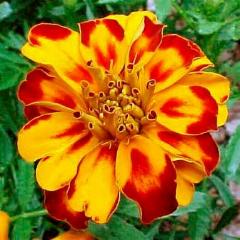| Marigold
 Brightly colored marigolds are easy to grow and are
incredibly versatile in the garden. Choose dwarf French types to plant as edgings or use
taller selections as feature flowers in mixed flowerbeds. Because plant size and habit
varies with selections, it is important to check the plant tags to see if the variety
grows to 10 inches or 2 feet. Marigolds will grow in many different soils. Plenty of sun
is needed to help them flower well. Plant marigolds in early spring. If you keep them
watered and snip off the old blooms as they fade, plants will continue flowering until the
first hard freeze. Brightly colored marigolds are easy to grow and are
incredibly versatile in the garden. Choose dwarf French types to plant as edgings or use
taller selections as feature flowers in mixed flowerbeds. Because plant size and habit
varies with selections, it is important to check the plant tags to see if the variety
grows to 10 inches or 2 feet. Marigolds will grow in many different soils. Plenty of sun
is needed to help them flower well. Plant marigolds in early spring. If you keep them
watered and snip off the old blooms as they fade, plants will continue flowering until the
first hard freeze.
Care
 Most marigolds grow lazy and would like to stop blooming for a few weeks
after transplanting. Proper fertilization helps them grow and resume flowering
quickly.
Just before planting marigolds in cultivated soil, mix in a plant food containing
timed-release fertilizer and extra phosphorous, such as 11-40-6. The extra phosphorous
will help the plants develop extensive roots. Most marigolds grow lazy and would like to stop blooming for a few weeks
after transplanting. Proper fertilization helps them grow and resume flowering
quickly.
Just before planting marigolds in cultivated soil, mix in a plant food containing
timed-release fertilizer and extra phosphorous, such as 11-40-6. The extra phosphorous
will help the plants develop extensive roots.
Marigolds
sometimes take a short break from blooming in the heat of summer. They will come back
strong in the fall if you fertilize in mid-summer with the same fertilizer used in
spring.
Sprinkle the fertilizer onto the soil between the plants and water well. Do not switch to
a high nitrogen fertilizer because too much nitrogen makes marigolds big and leafy with
only a few blooms. When growing marigolds in containers, fertilize them monthly by
sprinkling a teaspoon of fertilizer per plant atop the soil in the pots and watering
well.
Also, pinch off faded blooms before they have a chance to form
seeds. This will
help plants stay fresh and continue blooming. |
